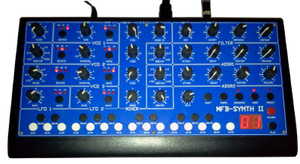News
2019
Embedded audio systems design under consideration for potential product releases...
2018
Orchestral composition ongoing...
2017
Ongoing work on patch libraries by MusicInclusive LLC for Roland Gaia, Korg Microkorg and Moog Little Phatty / Little Phatty Stage II.
Music
Some non-commercial sample tracks covering a variety of genres are available using the following playlists:
Classical:
Contemporary:
iOS:
Who we are
MusicInclusive™ LLC is an Indie label and publishing company
Calendar
|
Analog Synthesis (1.25V) Synthesizer Programming |
|||
|
|||
| The course will cover the basics of analog synthesis - from psychoacoustics to waveforms, from oscillators to filters, from envelopes to patches. |
|
|
Training will consist of live 2-day classroom events with hands-on analog synthesis sound production using real synthesizers alongside instructor-led tuition. Students will learn how to generate, modify and shape waveforms to produce all kinds of sounds - from emulating natural instruments to grungy synth basses and sparkling synth leads - from sound effects to "space music"! |

|
See the sound samples near the bottom of the page for examples of the sounds that you will learn how to develop in the class.
|
|
|
Who is it for?
The course is is designed to teach you how to make the best use of your analog synthesizer or VST® or RTAS® plugin, iPad® synthesizer application such as Animoog® or the the Korg iMS-20®, or any rack or patch-based digital or modeling or keyboard synthesizer based on an analog foundation.
You will be introduced to the principles that underpin your synthesizer's fundamental inner workings and learn how to go beyond the basic patches to create truly unique sounds.
Created and taught by musicians for musicians, “Analog Synthesis (1.25V)” is focused on firmly establishing you in the core elements of analog synthesis so that you will be able to use the same knowledge over and over again after the class to generate new sounds from your synthesizer.
Details
In this course you will learn how to:
|
 |
| Deploy low-frequency oscillators (LFOs) to alter sounds | |
| Manipulate amplifier stages (VCAs) to change sound levels | |
| Program and apply ADSR envelopes | |
| Apply ring modulation, noise and sample and hold to generate specific sound types | |
| Analyze and visualize the waveforms you create so as to better synthesize in the future | |
| Emulate real instruments and design and create new unique sound patches of your own! | |
| Dynamically modify sounds in real time during performances |
Hands-on exercises will include:
 |
|
Who should come on the course?
| Anyone who uses a synthesizer - whether analog or not. You will learn how the internals of synthesizers work. All of today's synthesizers - analog, digital, virtual, or some combination - are based on the principles of analog synthesis in some shape or form. |
|
| Anyone who has purchased a synthesizer or virtual synthesizer or is staring with bewilderment at a VST or RTAS plugin or iPad app and needs to better understand what all the knobs, dials, sliders and patch cables do |
|
| Anyone who has some experience in using or playing synthesizers but who wishes to begin to create their own new sounds |
|
| Seasoned musicians who wish to begin to explore the wonderful world of analog synthesis |
What level is the course aimed at?
MusicInclusive LLC is pleased to offer the Analog Synthesis course to anyone from senior high-school level through to professional musicians.
Authors and instructor
 |
Derek Jones Derek Jones (Interplekt) is a musician, performer and synthesizer programmer and player. He has been working with keyboards and synthesizers (among other instruments) since the 1970's. He is also an electronic engineer and a experienced educator, course designer and instructor, having written classroom and online training material and has professionally taught age ranges from 7 to 70+ over a period spanning 30 years.
|
To secure your seat, click here to book a course place now
Here are some sound samples illustrating a few of the patch types that attendees on the course will learn how to make from scratch.
All these patches except the "LPSII 1st Improv" are made with the iMS-20 on the iPad.
No effects were used in any DAW for the iMS-20 examples. Some of the built in iMS-20 reverb was used on most of the iPad samples and the iMS-20 flanger and chorus effects on a couple.
They demonstrate what it's possible to get the iMS-20 to produce that mimic real instruments, voicings, effects and synths purely from the instrument itself.
The "LPSII 1st Improv" sample is a demonstration of the Moog Little Phatty Stage II we will also have in class
|
Background requirements While every effort will be made to fill in any gaps in knowledge during the course, MusicInclusive recommends that the following minimum requirements be met in order to obtain the most satisfaction from the event: |
|
| A basic understanding of math principles covering: ratios, geometric shapes, elementary trigonometry (sine waves and sin/cos functions), linear vs. logarithmic scales – needed to understand dB graphs – exponential units |
|
| A basic understanding of general science principles including: force, power, energy, frequency, amplitude, voltage, current You will not need to do any math involving these in the course! |
|
|
An elementary understanding of music theory including: pitch, tunings, keyboard/piano notes and scales, intervals, key signatures, major and minor keys, melody, harmony and chords You do not have to be a proficient performer nor be able to sight read music. |
|
